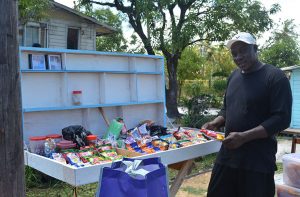Dartmouth, on the Essequibo Coast, was at one time referred to as “no man’s land” since it was a bushy strip of land that was never utilised for cultivation by the Dutch and British colonisers.The area during the time of slavery was said to be somewhat of a maroon community, because slaves who escaped from their masters used to go there and take up residence among the thick vegetation.

The village has a proud history of being a sanctuary for the distressed. During the period of Indentureship, Indians who were thrown out of their logies by plantation owners also used to seek refuge at Dartmouth. There they were welcomed by the African settlers and provided with food and temporary lodging until they ‘got back on the feet’.
Dartmouth at the time was a cul-de-sac. There was no road leading to Charity, and the area going further towards Charity was a dense jungle.
The Indians at the time referred to the village as “ludgejaa”, an Urdu word meaning “turn back”, since the area beyond the village was at the time inaccessible.
At about 1860, leadership tendencies in the village began to emerge, and a system of democracy, communal work, religion and education took shape.
Dartmouth has produced a number of outstanding Guyanese. Among them are the Annamantadoos (Indians of Madras descent), who were doctors; and the Brummels and Clays, who were community leaders.
The first Chairman of Region Two, Mr. Kenneth Hopkinson, hails from Dartmouth. His son Rupert Hopkinson is currently the Regional Executive Officer of Region Two.

The most famous Dartmouth resident was the late statesman Dr. Ptolemy Reid, one time Minister of Agriculture and Prime Minister of Guyana, whose statue adorns the nursery school in the village. Dr. Reid is remembered as a benevolent man. Dartmouth residents relate that before he became a Government minister, Dr. Reid had been a school teacher and a vibrant community leader.
The residents recalled an incident in which a pregnant woman delivered twins at the Charity stelling and there was no hospital nearby to provide her medical attention. Dr. Reid, who saw the delivery, was greatly concerned about the situation, they say. At the time there was a dispensary at Charity which was housed in a two-storey building. Below was the dispensary and above the dispenser’s quarters. Following the incident, the residents say, Dr. Reid ordered that a building be constructed next to the dispensary to accommodate the dispenser, and the upper flat of the dispensary be converted into a cottage hospital.
This decision, they say, brought joy to the hearts of the residents of the Essequibo Coast, especially those in the Charity/Pomeroon community.
The residents also related that Dartmouth, over the years, has developed by leaps and bounds. Following Emancipation, freed slaves bought the village from the British planters, and in the process of time, transformed it from a virtual swampland into a thriving, bustling community today.

Today Dartmouth boasts of durable farm-to-market roads; a good drainage system; a health centre; a community centre ground; nursery, primary and secondary schools; shops, and a spanking new modern hotel. The village is located some eight miles from Anna Regina, heading in the direction of Charity, and is primarily a farming community. The friendly residents cultivate mainly cash crops, rear pigs and do mining for a living. Some residents have taken up jobs in the Police Force, and like some villages on the Essequibo Coast, Dartmouth has been affected by migration.
Residents also related that the village once had a very rich spiritual culture. They told Guyana Chronicle that, years ago, when the river defence for the village was being built, part of it cut through a burial ground; and despite all efforts by the engineer, it was failing to hold. To remedy the problem, the villagers say, an Obeah Man was summoned, and after a reading, the engineer returned to work and the sea defence has been holding together solidly, even to this day.




.png)









